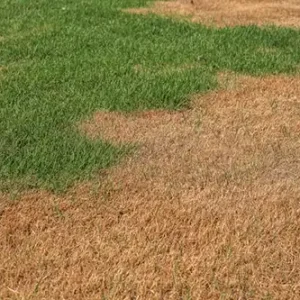How Can I Tell If My Lawn Needs More Water?
Here in Florida, it can be challenging to ensure your lawn is getting enough water – especially during a dry summer. Knowing the signs of underwatering can help you get your watering schedule back on track.
IDENTIFYING SIGNS OF UNDERWATERING
Here are some indications that your lawn needs more water:
- Blades rolling or wilting: When the grass leaves start to wilt, your lawn is likely under stress due to insufficient watering. You may also notice grass blades “rolling” inward, almost like a taco. This is often more obvious during the peak heat of the day.
- Change in color: Fading or discoloration could mean that your grass is experiencing drought stress and would benefit from more water. Look for yellowish, brown, or tan patches of dry and brittle grass.
- Footprints: If you notice footprints on your lawn that don’t disappear quickly, your grass likely needs more frequent waterings. Most footprints should vanish within 30 minutes or less; anything longer could indicate dehydration.
- Reduced growth or slow recovery: If your grass is slow to recover after mowing or shows limited growth, it may be a sign that it needs more water to support its growth and repair processes.
Additionally, dry and crumbly soil, along with a lack of new growth, can indicate insufficient moisture.
OPTIMAL WATERING PRACTICES FOR HEALTHY GRASS
When watering, it is recommended to follow best practices such as deep and infrequent watering, preferably in the early morning, to encourage robust root growth and efficient water usage. Continuously monitor your lawn’s condition and adjust your watering schedule accordingly, considering the specific requirements of your lawn, climate, and soil type. For warm-season grasses, such as St. Augustine or Bahia, it’s recommended to water to a depth of 6-8 inches of soil, ensuring deeper roots and drought tolerance. Utilize a rain gauge to measure rainfall and supplement when necessary. A well-calibrated sprinkler system can efficiently deliver the right amount of water, typically requiring 1-1.5 inches per week, depending on the weather conditions. Remember, the time to water is in the early morning to minimize water loss due to evaporation, promoting optimal absorption by the grass.

Ready for your INSTANT quote?
Click the button below to leave your information and we’ll be in touch with a free quote!
METHODS FOR AN EFFECTIVE LAWN WATERING SCHEDULE
For Florida’s climate, where warm-season grasses thrive, we recommend watering two to three times per week, adjusting based on rainfall and temperature fluctuations. Cool-season grasses like Kentucky Bluegrass may require less frequent watering. By providing the right amount of water consistently, you can encourage deeper roots and stronger grass, resulting in a lush and vibrant lawn year-round.
Get Expert Lawn Irrigation Services
It is important to recognize that these signs can also point to other lawn problems, such as compacted soil or nutrient deficiencies. By observing multiple signs and taking into account factors like weather conditions, recent rainfall, or seeking advice from a professional, you can make an informed decision regarding watering your lawn.
If you need great lawn care services, reach out to your local experts at Heron Home & Outdoor! We have over 20 years of experience caring for lawns across Florida, so we understand the environmental factors that can influence your lawn’s health. From setting up your irrigation setting to providing you with other treatments like soil care, we’ve got you covered.
How can I tell if my lawn needs more water Serving Orlando and surrounding counties?
Serving satisfied customers in:


